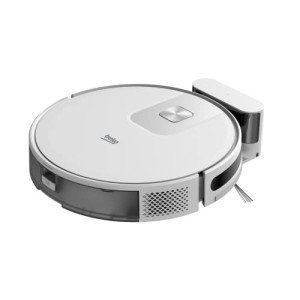In today's fast-paced world, the need for convenience and performance in home chores is higher than ever. In the middle of the pressure of every day life, finding time for comprehensive cleaning can feel like a high-end. This is where the innovative world of vacuum mop cleaner robotics steps in, offering an assisting hand in keeping pristine floors with minimal effort. These ingenious gadgets are no longer a futuristic dream however a concrete truth, rapidly becoming a staple in modern-day homes. By combining the functions of vacuuming and mopping into a single, automatic unit, these robotics guarantee to transform home cleaning, enabling individuals to recover their valuable time and delight in regularly clean home.
Vacuum mop cleaner robotics represent a considerable leap forward in home automation. They are smart, self-navigating devices created to autonomously tidy floors, dealing with both dust, particles, and spills with remarkable ease. These robotics are not merely upgraded vacuum; they are sophisticated cleaning systems equipped with advanced sensors, smart algorithms, and dual cleaning systems to supply a detailed floor cleaning solution. As technology continues to advance and prices end up being more available, the appeal of these robotic assistants is only set to grow, guaranteeing a future where sparkling clean floorings are effortlessly preserved by our automated allies. This article will look into the world of vacuum mop cleaner robotics, exploring their functionality, advantages, types, crucial considerations when picking one, and what the future holds for these progressively popular household companions.
The magic behind vacuum mop cleaner robotics lies in their intricate mix of hardware and software application. These devices effortlessly incorporate vacuuming and mopping abilities, running autonomously to provide a comprehensive cleaning experience. Understanding their inner functions is crucial to valuing their effectiveness and picking the right model for particular needs.
At their core, vacuum mop cleaner robots use a combination of innovations to navigate and tidy efficiently. Here's a breakdown of their key operational parts:
Navigation and Mapping: Modern robot vacuum mops make use of advanced navigation systems to comprehend and map their cleaning environment. Numerous high-end designs employ LiDAR (Light Detection and Ranging) innovation, which utilizes lasers to develop a detailed map of the room. This permits effective cleaning paths, systematic room protection, and barrier avoidance. Other robots may make use of camera-based visual SLAM (Simultaneous Localization and Mapping) or rely on infrared sensing units and gyroscopes for navigation. Easier designs may utilize a more random or bounce-based navigation system, which, while less efficient, still does the job with time.
Vacuuming System: The vacuuming function is usually powered by a motor that develops suction. This suction, integrated with turning brushes underneath the robot, raises dust, dirt, pet hair, and other debris from the floor. Gathered debris is then funnelled into an internal dustbin. The suction power and brush style can vary in between designs, affecting their efficiency on different floor types and in selecting up different kinds of dirt.
Mopping System: This is where vacuum mop robots truly separate themselves. They are geared up with a water tank and a mopping pad. Water is given onto the pad, which is then dragged or rotated throughout the floor surface. Various models use numerous mopping mechanisms:
Sensors and Intelligence: A variety of sensors are crucial for robot operation. Cliff sensing units avoid robotics from dropping stairs. Bump sensors detect barriers. Wall sensing units enable edge cleaning. The robot's software and algorithms procedure sensing unit information to make smart choices about cleaning courses, obstacle avoidance, and returning to the charging dock when the battery is low or cleaning is total. Numerous robotics now use smartphone app combination, allowing features like scheduling, zone cleaning, and real-time monitoring.
The popularity of vacuum mop cleaner robotics is not simply a passing pattern; it is rooted in the tangible advantages they offer to contemporary households. Buying one of these gadgets can considerably improve your lifestyle and home environment in numerous methods:
Time and Effort Savings: This is maybe the most engaging advantage. Robot vacuum mops automate a time-consuming task, releasing up your valuable time to concentrate on other concerns, whether it's work, household, hobbies, or simply relaxation.
Constant Cleanliness: Unlike manual cleaning which may be sporadic, robotics can be configured to clean daily or perhaps multiple times a day, ensuring consistently tidy floors and a much healthier living environment.
Reaching Under Furniture: Their low profile permits robotics to effortlessly navigate under furniture like beds, sofas, and cabinets, areas that are typically difficult to reach with conventional vacuums and mops.
Set up Cleaning: With app control and scheduling functions, you can set the robot to clean up at specific times, even when you're not home. Picture coming home to freshly cleaned floors every day without lifting a finger!
Improved Air Quality: By regularly vacuuming and getting rid of dust and irritants from floors, robot vacuum mops add to improved indoor air quality, which can be particularly useful for individuals with allergic reactions or respiratory sensitivities.
Lowered Physical Strain: For people with mobility issues, back problems, or merely those who find vacuuming and mopping physically requiring, a robot cleaner offers a welcome reprieve, removing the need for laborious exercise.
Pet Hair Management: Robot vacuum mops are especially efficient at taking on pet hair, a typical home nuisance for pet owners. Routine cleaning decreases pet dander and keeps homes cleaner and more hygienic for both family pets and their owners.
The marketplace for vacuum mop cleaner robots varies, with various models accommodating different needs and spending plans. Understanding the various types can assist you make an informed option:
2-in-1 Vacuum and Mop Robots: These are the most common type, combining both vacuuming and mopping functionalities in a single unit. They normally change between modes or operate both concurrently depending on the model.
Devoted Vacuum Robots with Mopping Attachment: Some robotics are primarily designed for vacuuming but provide a detachable mopping module. These might be a great choice for those who prioritize strong vacuuming abilities however desire occasional mopping functionality.
Dry Mopping vs. Wet Mopping Robots: While practically all "mop" robotics provide wet mopping to some degree, some are much better fit for mostly dry sweeping and light wet mopping for dust elimination. Others are developed for more robust wet mopping with features like adjustable water circulation and scrubbing pads.
Navigation Technology Based Classification:
Feature-Based Classification:
With a broad variety of alternatives available, picking the best vacuum mop robot requires mindful consideration of your particular needs and home environment. Here are some key factors to evaluate:
To guarantee your vacuum mop robot continues to perform optimally and delights in a long life expectancy, regular maintenance is essential. Simple maintenance tasks can significantly affect its performance and longevity:
The development of vacuum mop cleaner robotics is far from over. The future holds amazing possibilities and improvements poised to further enhance their abilities and combination into our lives:
In Conclusion:
Vacuum mop cleaner robotics are no longer a futuristic novelty but a valuable and practical addition to the contemporary home. They offer an engaging solution for busy people and households looking for to preserve clean floorings with very little effort. By comprehending their functionality, benefits, types, and key considerations, you can make a notified decision and choose a robot that completely complements your way of life and cleaning requirements. As technology continues to advance, these automated cleaning buddies will only end up being more smart, effective, and vital in our quest for cleaner, healthier, and more convenient living spaces.
Q: Are vacuum mop cleaner robots worth the money?A: For many, the response is yes. The time and effort conserved, combined with regularly tidy floorings and the convenience of automated cleaning, frequently outweigh the preliminary investment. Consider your lifestyle and how much you value your time and tidiness when making this decision.
Q: Can robot vacuum mops replace regular vacuums and mops entirely?A: For daily cleaning and upkeep, they can considerably reduce or perhaps eliminate the need for traditional vacuums and mops. Nevertheless, for deep cleaning, tackling big spills, or cleaning upholstery and other surface areas, you might still need a traditional vacuum or mop.
Q: Do robot vacuum mops deal with all floor types?A: Most modern-day robotics work well on tough floors like tile, hardwood, laminate, and vinyl. Lots of can likewise deal with low-pile carpets and rugs. However, extremely thick carpets or shag rugs may position obstacles for some models. Always examine the producer's specs for floor type compatibility.
Q: What type of upkeep is needed for a vacuum mop robot?A: Regular upkeep includes clearing the dustbin, cleaning brushes, cleaning or changing filters, cleaning mopping pads, and periodically cleaning sensors. Maintenance frequency differs depending upon use and the particular design.
Q: How long do vacuum mop robots normally last?A: The life expectancy of a robot vacuum mop depends upon usage, maintenance, and develop quality. Usually, with proper care, a great quality robot can last for a number of years (3-5 years or more). Battery life might deteriorate gradually and may ultimately need replacement.
Q: Are vacuum mop robots safe for pets and kids?A: Generally, yes. They are designed to navigate around barriers. However, it's constantly sensible to supervise family pets and little kids initially to ensure they don't interfere with the robot's operation or vice versa. Keep small things and cables out of the robot's path to avoid entanglement.
Q: Can robot vacuum mops climb up stairs?A: No, most robot vacuum mops are developed for single-level cleaning. They are equipped with cliff sensors to avoid them from falling down stairs, however they can not climb up stairs themselves. For multi-level homes, you would usually need a robot for each level or by hand move the robot in between floorings.

Q: How noisy are vacuum mop robots?A: Noise levels vary in between designs. Usually, they are quieter than conventional vacuum cleaners. Lots of run at a noise level equivalent to a peaceful discussion. Some models offer a "quiet mode" for even quieter operation.
Q: Can I use cleaning services in the water tank of a robot mop?A: It is important to inspect the producer's suggestions. Some robotics are developed to only use plain water in the water tank. Using certain cleaning options can harm the robot or void the guarantee. If allowed, utilize only moderate, diluted cleaning options particularly authorized for robot mops.
No Data Found!

